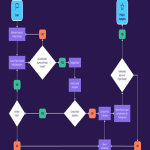We’ve cracked the code on where we work. The policy is set: three days in the office, two days remote. But while the logistics are solved, a more insidious problem has taken root for many Canadian tech companies: the erosion of the connective tissue that fuels innovation. The spontaneous hallway conversations, the quick whiteboard sessions, the mentorship that happens by osmosis—these have been replaced by scheduled, often transactional, video calls.
The next great challenge for leaders is not managing hybrid work, but rebuilding a intentional culture that thrives within it. The goal is to recreate the innovation of the office floor in a digital-first reality.
From Serendipity to Structure
You can’t mandate spontaneity. Instead, you must design for it.
Digital Water Coolers: Create dedicated virtual spaces for non-work interaction (e.g., Slack channels for #gaming, #parenting, #hockey). Sponsor optional, facilitated virtual social events like trivia or coffee chats with randomized groups.
Async Innovation Sprints: Don’t default to a meeting for every idea. Use tools like Miro or FigJam to create digital whiteboards where teams can contribute ideas, feedback, and prototypes asynchronously, building on each other’s work across time zones.
Rethinking the Office for Collision
The office must earn its commute. Its purpose must shift from individual work to intentional connection.
Anchor Days: Designate specific days for teams to be in the office together, focused on collaboration, planning, and relationship-building. Make these events valuable with catered lunches or guest speakers.
Design for Collaboration: Ditch the sea of desks. Create an abundance of meeting rooms, huddle spaces, and comfortable areas designed specifically for impromptu team meetings.
Leading for Outcomes, Not Presence
The most significant shift is required from your managers. Micromanagement is a culture killer in a hybrid model.
Train Your Managers: Equip them with the skills to lead distributed teams. This means setting clear goals and outcomes, trusting their teams, and measuring performance based on results, not hours logged online.
Onboard with Intent: A new hire’s first experience cannot be a laptop arriving by courier and a calendar full of Zoom calls with strangers. Create a structured, multi-week onboarding buddy program that intentionally builds their internal network.
A thriving hybrid culture isn’t about replicating the office online. It’s about building something new—something more flexible, inclusive, and intentional. The companies that master this will not only protect their innovation engine; they will win the war for top Canadian tech talent who demand this very flexibility.
Summit Crest Global’s Human Capital practice helps leaders design organizations and cultures fit for the future. Contact us to audit your hybrid work strategy.



